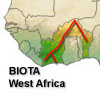 



Weather data
A large number of automatic weather stations has been implemented in the frame of the BIOTA AFRICA project by the Namibian National Botanical Research Institute (NBRI) and the Group "Biodiversity, Evolution and Ecology" (BEE) of the University of Hamburg. The website offers hourly updates of data and graphs of a large number of weather parameters.

|
 BIOTA West Africa - Workpackage - CT2-T2-WP5
BIOTA West Africa - Workpackage - CT2-T2-WP5
Core Topic (CT) |
Land use changes: agriculture and restoration |
Topic (T) |
Sustainable use of selected organisms |
Title |
 Ecology and sustainable use of edible mushrooms of fungus growing termites
Ecology and sustainable use of edible mushrooms of fungus growing termites
|
Project leader(s) |
Prof. Dr. K. Eduard Linsenmair
Dr. Souleymane Konaté
|
Project description |
Termite species of the subfamily Macrotermitinae live in an obligatory exosymbiosis with fungi of the genus Termitomyces. The implications of this symbiosis are of great ecological and economical importance in West Africa. The carpophores (mushrooms) of some Termitomyces species are used for human nutrition and as animal fodder and are of high socio-economical importance for the local population. However information on the biological prerequisites for the production of this edible mushroom and knowledge on its sustainable use are lacking.
The aim of the project is to analyse the ecological and economical implications of harvesting edible Termitomyces mushrooms. Three main objectives are addressed:
- the diversity and spatio-temporal distribution of mushrooms producing termite species are studied in the Lamto reserve and especially in its anthropogenically altered surrounding areas, where mushroom harvesting takes place;
- in an experimental approach the biological mechanisms and factors, which govern and determine the fructification of the mushrooms are studied, aiming at a future domestication;
- socio-economical studies are realised in order to assess the main threats for Termitomyces species and to analyse options for a sustainable use of the mushrooms with special focus on its possible production in (e.g. cocoa or rubber) plantations.
|
|
|






 Go to the WeatherNet
Go to the WeatherNet BIOTA West Africa - Workpackage - CT2-T2-WP5
BIOTA West Africa - Workpackage - CT2-T2-WP5 Ecology and sustainable use of edible mushrooms of fungus growing termites
Ecology and sustainable use of edible mushrooms of fungus growing termites